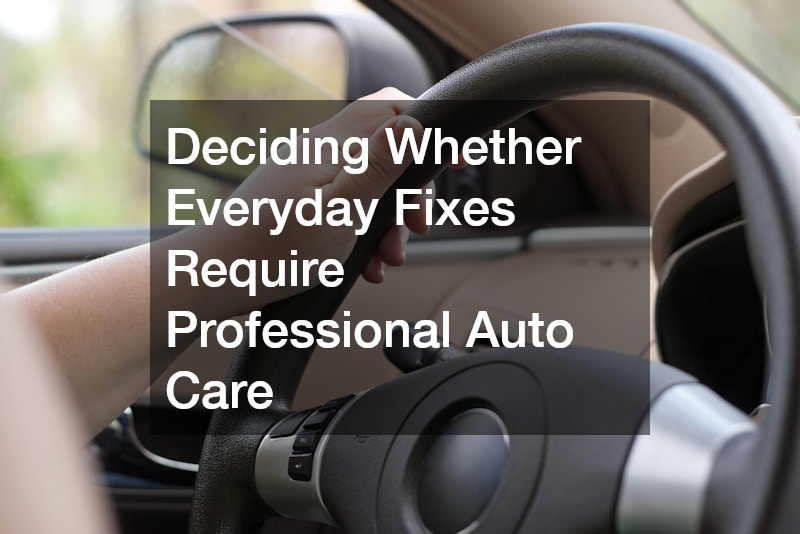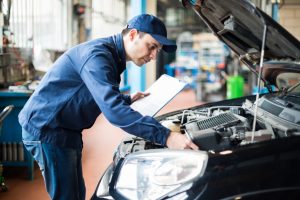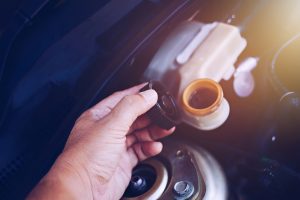When something goes wrong with your vehicle, it is tempting to consider fixing the issue yourself. DIY auto work can seem cost-effective, satisfying, and sometimes faster than scheduling a professional appointment. However, modern vehicles are increasingly complex, packed with electronic systems, specialized components, and safety features that require precise tools and training. Choosing between attempting a repair on your own or seeking professional help involves weighing your skill level, the risks involved, and the potential consequences of improper work. A mistake can lead to bigger and more expensive problems, but certain basic tasks may still be manageable for experienced DIY enthusiasts. Understanding which repairs fall into which category can help you make better decisions that protect your safety, your vehicle, and your budget.
Deciding Whether Everyday Fixes Require Professional Auto Care
Some automotive tasks appear simple on the surface, but they often involve more steps than most people realize. Routine vehicle maintenance requires correct tools, accurate torque levels, and a clear understanding of how interconnected systems work together. Even basic mistakes can compromise your car’s performance or create new mechanical problems that may not be noticeable until they become more serious. Before starting any project, it is important to assess whether the repair affects essential systems such as steering, brakes, or engine performance. When the risk outweighs your confidence or experience, turning to a professional can prevent unnecessary damage and ensure long-term reliability.
More specifically, attempting auto repair without proper training can lead to misdiagnosed issues, damaged parts, or incomplete fixes that end up costing far more than the original problem. Jobs involving wiring, fluid lines, or suspension components require knowledge and precision that most DIY hobbyists do not have. If a repair demands specialized tools or deals with safety-critical components, it is usually best to leave it to an expert who performs these tasks daily.
Evaluating the Safety Risks of Handling Cooling System Issues
The cooling and climate systems in vehicles are intricately designed, making air conditioning repairs particularly challenging for the average DIYer. These systems operate under high pressure and rely on components that must be handled with care to avoid leaks, damage, or personal injury. What may seem like a minor issue—such as weak airflow or inconsistent cooling—can actually indicate deeper problems within the system. Without proper diagnostic tools and an understanding of how these parts interact, it is easy to make mistakes that worsen the condition or create new hazards.
More specifically, car ac repair should usually be performed by trained professionals who have the correct equipment to measure refrigerant pressure, detect leaks, and identify failing components accurately. Refrigerant handling requires certification and must be managed safely, as accidental release is both dangerous and expensive to correct. A professional technician can ensure the AC system is repaired correctly and safely, preventing further issues and helping your vehicle maintain dependable climate control.
Determining If Appearance Upgrades Are Safe to Do Yourself
Cosmetic enhancements can be tempting DIY projects because they often look simple at first glance. Many appearance-related upgrades seem harmless, but they can still require steady hands, the right tools, and a clear understanding of the materials involved. Even small mistakes can reduce visibility, weaken a protective component, or create bubbling, peeling, or uneven finishes that are difficult to undo. Before attempting an aesthetic upgrade, it is important to consider how permanent the modification is, how difficult it will be to reverse, and whether a mistake could compromise your vehicle’s safety or value. Some cosmetic tasks can be rewarding DIY projects, but others are better left to trained professionals who can guarantee a clean, durable result.
More specifically, auto glass tinting is far more delicate than most people expect. Proper tint installation requires precise measurements, a dust-free workspace, and the correct tools to avoid gaps, wrinkles, or air bubbles. If done incorrectly, tint can reduce visibility, violate local regulations, or damage the glass surface. Professional installers ensure the tint adheres smoothly, meets legal standards, and lasts longer without peeling or fading.
Recognizing When Visibility Problems Demand Expert Help
Your windshield plays a critical role in both safety and visibility, making anything that affects its clarity or structure extremely important. While some drivers may feel comfortable attempting small fixes, many windshield-related issues require specialized tools and adhesives that are not readily available to the average car owner. Poor installation or repair can compromise the vehicle’s structural integrity, interfere with airbag deployment, or reduce visibility during difficult driving conditions. Because windshields contribute to the overall strength of the vehicle’s cabin, mistakes in this area can have serious consequences.
More specifically, local windshield replacement should never be approached as a DIY task. Professional technicians use manufacturer-approved adhesives, precision tools, and strict installation procedures to ensure the glass is secured correctly. Even slight errors in alignment or curing can lead to leaks, rattling, or complete failure in a collision. By relying on experienced experts, you ensure your windshield performs as intended and maintains the safety standards your vehicle was designed to meet.
Assessing Structural Damage That Should Never Be DIY
Any repair involving structural or impact-related damage goes far beyond what most DIYers can safely handle. Modern vehicles are built with complex crumple zones, reinforced frames, and safety features that depend on precise measurements and calibrated equipment. Attempting to fix collision damage at home can make the vehicle unsafe, reduce resale value, and create hidden weaknesses that only show up during future accidents or repairs. When a repair affects alignment, door fit, panel structure, or internal frame components, experience and professional tools become essential.
More specifically, auto collision repair requires specialized training to restore a vehicle’s structure, body panels, and safety systems to their original condition. Professional technicians use frame machines, welding equipment, and diagnostic tools designed for exact measurements and factory-level accuracy. Their work ensures that airbags deploy correctly, the frame remains stable, and the vehicle maintains its crash protection. DIY attempts in this area carry high risks, making professional repair the only safe choice.
Identifying Glass Repairs That Require Specialized Tools
Small chips or cracks in your car’s glass can seem like simple issues, but repairing them correctly requires precision and the right materials. Many DIY kits claim to offer easy solutions, yet they often fail to fully seal the damage or prevent cracks from spreading. Glass repairs must be done carefully to preserve structural integrity, prevent visibility issues, and ensure the glass does not weaken over time. Even minor imperfections can worsen with temperature changes or vibration while driving. Before attempting any repair yourself, it is important to consider whether the damage is something a kit can handle or whether a more advanced approach is needed.
More specifically, auto glass repairs done by professionals use high-quality resins, curing equipment, and specialized tools that create stronger, more reliable results. Technicians know how deep a crack is, whether a chip has compromised the glass layer, and whether the windshield needs reinforcement. Their expertise ensures the repaired area remains safe and reduces the chance of further cracking. DIY repairs may seem inexpensive, but improper work can lead to larger, more costly issues down the road.
Understanding the Complexity of Luxury Vehicle Maintenance
Luxury vehicles come with advanced engineering, specialized components, and electronics that require precise hands and detailed knowledge. These cars are designed with performance standards that rely on exact calibration, meaning even small errors during maintenance can affect drivability, comfort, or safety. Attempting to work on these vehicles without proper training can quickly lead to accidental damage or system failures. Owners of high-end vehicles should always consider how complicated their systems are before deciding to handle repairs independently.
More specifically, bmw repair often involves proprietary diagnostic tools, specialized parts, and procedures that only trained technicians fully understand. The brand’s engines, suspension setups, electrical networks, and onboard computers are engineered to exact specifications. Attempting DIY maintenance on these vehicles can trigger warning lights, disrupt performance settings, or cause expensive damage. Professional service ensures that everything functions as intended and preserves the long-term reliability and value of the vehicle.
Knowing When Steering and Suspension Adjustments Need Precision
Steering and suspension systems play a major role in how stable, safe, and responsive your vehicle feels on the road. Even small misalignments can cause uneven tire wear, poor handling, vibrations, and long-term mechanical damage. While some drivers consider alignment a minor adjustment, it is actually a highly technical process that requires specialized machines, measurement tools, and careful calibration. Doing this work incorrectly can put you at risk every time you drive, especially at higher speeds or in challenging conditions.
More specifically, a local car alignment shop uses computerized alignment machines that measure angles with extreme precision. These tools ensure your wheels are correctly positioned according to manufacturer specifications, which enhances safety, improves fuel efficiency, and extends the life of your tires. DIY attempts simply cannot replicate the accuracy of professional equipment, and small mistakes can lead to significant problems. For this reason, steering and suspension adjustments should always be handled by trained experts who understand the complexities involved.
Weighing the Challenges of Handling Tire Replacement at Home
Tire-related maintenance is one of the most common vehicle needs, but that does not mean it is always simple to handle on your own. Changing or installing new tires requires heavy lifting, proper torque application, and an understanding of how tire pressure, tread patterns, and wheel balance affect overall performance. Without the right tools or experience, you risk improper installation, which can lead to wobbling, shaking, blowouts, or uneven wear. Tires are a crucial part of your vehicle’s safety system, and any mistake can create dangerous driving conditions. While replacing a tire might look straightforward, the details involved make it more challenging than many people expect.
More specifically, new tire service performed by professionals ensures that each tire is mounted correctly, the wheels are balanced, and the lug nuts are tightened to the exact specification required by the manufacturer. Shops also check for damage, alignment issues, and hidden problems that could affect the new tires’ lifespan. Attempting this work at home without proper equipment can lead to costly complications and safety hazards, making professional service the more reliable and secure option.
Exploring Protective Coatings and Whether DIY Results Can Compare
Protective coatings have become increasingly popular among car owners who want to preserve their paint and maintain a glossy finish. While many products are marketed as DIY-friendly, applying coatings correctly takes patience, precision, and a controlled environment. Surface preparation is one of the most important steps and often requires polishing, decontaminating, and leveling the clear coat before any product can be applied. Skipping or mishandling these steps can lead to streaking, uneven shine, or trapped contaminants that ruin the final result. For many car owners, the amount of effort and skill required makes this task more demanding than expected.
More specifically, car ceramic coatings delivered by professionals offer superior durability and appearance because technicians use high-grade materials and follow strict multi-step preparation procedures. They have the tools to correct paint imperfections, properly apply the coating, and ensure it cures under the right conditions. While DIY kits exist, they rarely achieve the same hardness, gloss, or longevity as professional applications. Choosing expert installation protects your car’s exterior more effectively and preserves its value for years to come.
Deciding whether to DIY an auto repair requires an honest assessment of your skills, tools, and comfort level with potential risks. While certain small tasks can be manageable for experienced hobbyists, many repairs involve specialized equipment, safety considerations, or technical knowledge that go far beyond what a typical car owner can safely handle. Modern vehicles are built with complex systems that demand precision, and an incorrect repair can easily create new problems or compromise your safety on the road. Evaluating the difficulty, cost, and potential consequences of each task can help you make smarter decisions that protect both your vehicle and your wallet. When in doubt, choosing a qualified professional ensures that the job is done correctly and your car remains reliable, safe, and ready for the road ahead.















